wonderful discussion with shri jkp sir and associates regarding UREA PLANTS
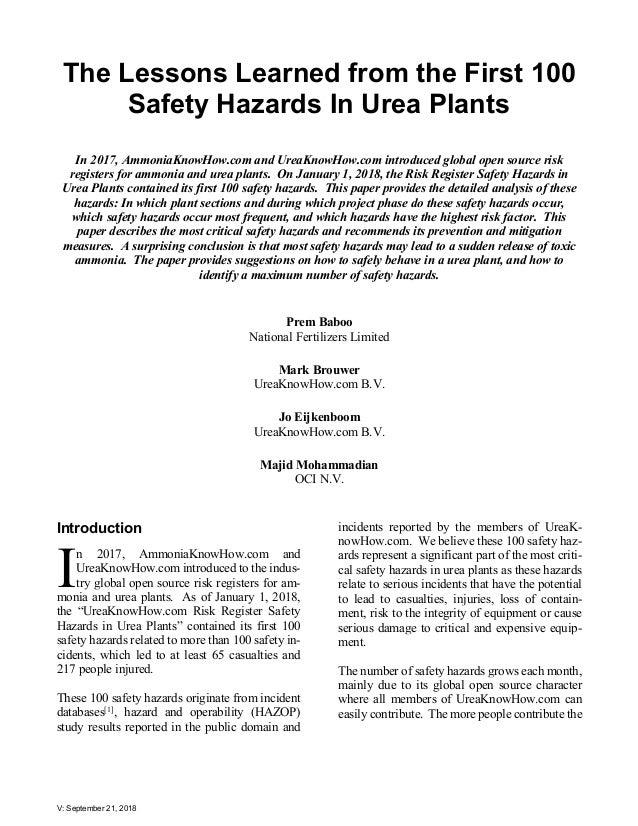

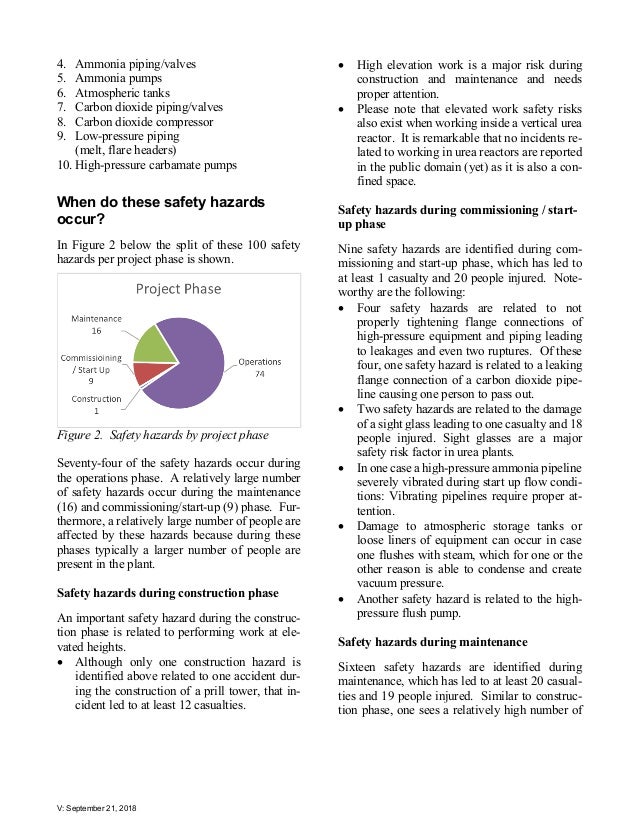

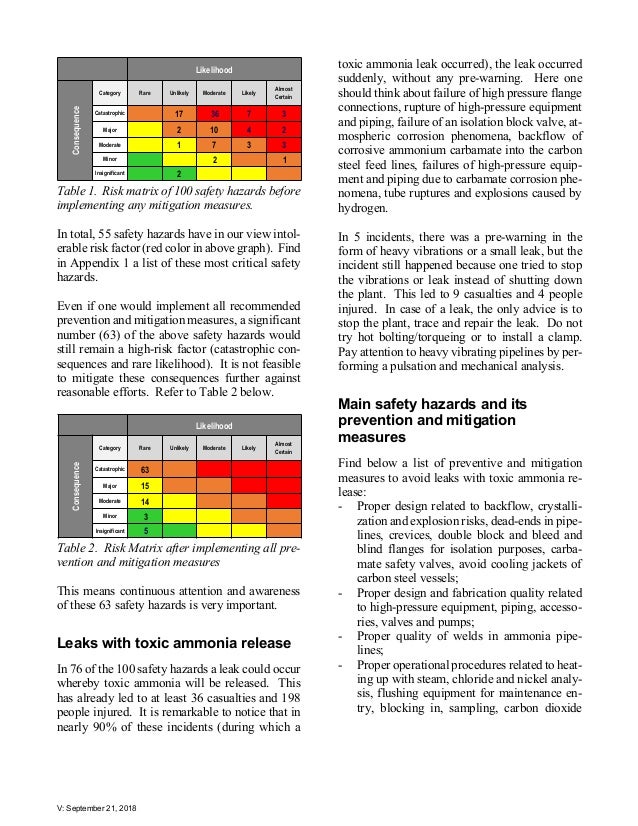
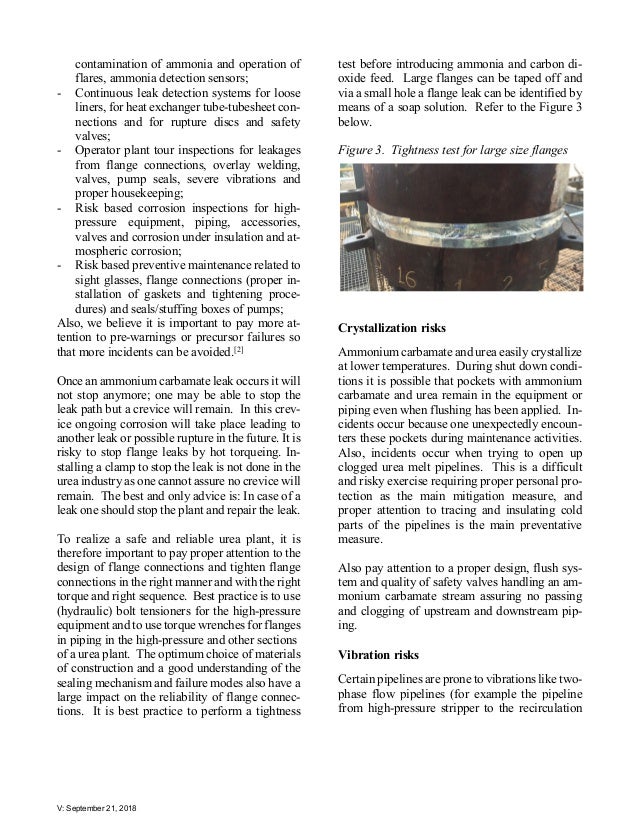
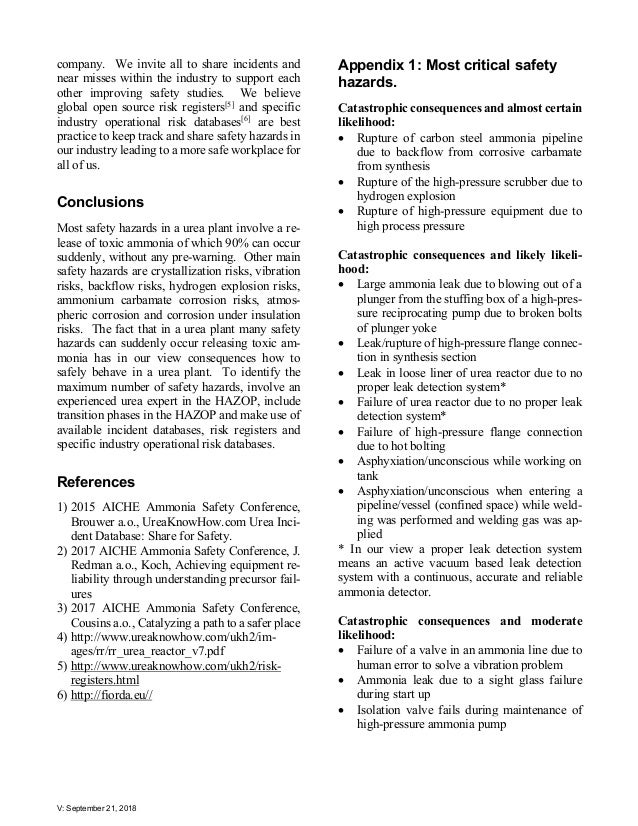
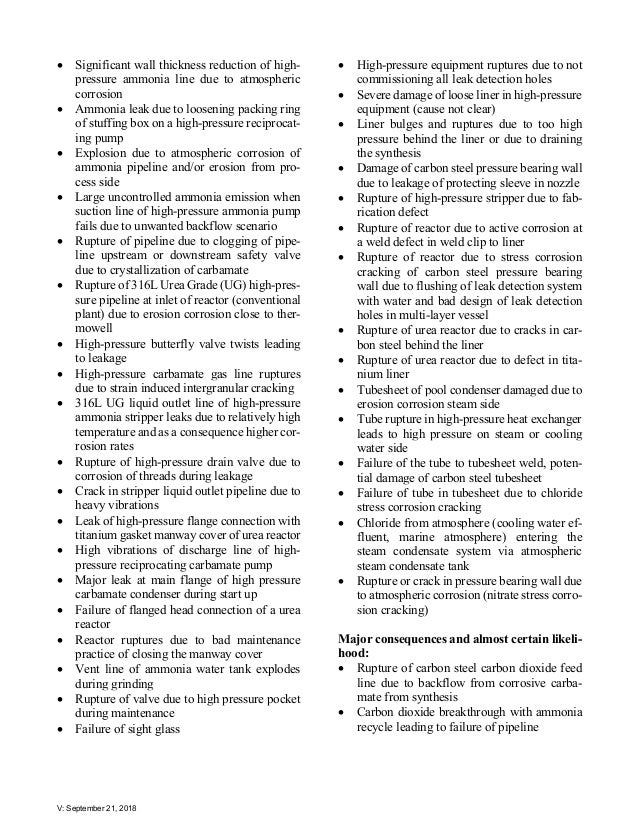








The lessons learned from the first 100 safety hazards in urea plants (1) (1)
- 1. T Technical Paper October 2018 1 The Lessons Learned from the First 100 Safety Hazards In Urea Plants Authors Prem Baboo National Fertilizers Limited Mark Brouwer UreaKnowHow.com B.V. Jo Eijkenboom UreaKnowHow.com B.V. Majid Mohammadian OCI N.V. Summary In 2017, AmmoniaKnowHow.com and UreaKnowHow.com introduced global open source risk registers for ammonia and urea plants. On January 1, 2018, the Risk Register Safety Hazards in Urea Plants contained its first 100 safety hazards. This paper provides the detailed analysis of these hazards: In which plant sections and during which project phase do these safety hazards occur, which safety hazards occur most frequent, and which hazards have the highest risk factor. This paper describes the most critical safety hazards and recommends its prevention and mitigation measures. A surprising conclusion is that most safety hazards may lead to a sudden release of toxic ammonia. The paper provides suggestions on how to safely behave in a urea plant, and how to identify a maximum number of safety hazards.
- 2. V: September 21, 2018 The Lessons Learned from the First 100 Safety Hazards In Urea Plants In 2017, AmmoniaKnowHow.com and UreaKnowHow.com introduced global open source risk registers for ammonia and urea plants. On January 1, 2018, the Risk Register Safety Hazards in Urea Plants contained its first 100 safety hazards. This paper provides the detailed analysis of these hazards: In which plant sections and during which project phase do these safety hazards occur, which safety hazards occur most frequent, and which hazards have the highest risk factor. This paper describes the most critical safety hazards and recommends its prevention and mitigation measures. A surprising conclusion is that most safety hazards may lead to a sudden release of toxic ammonia. The paper provides suggestions on how to safely behave in a urea plant, and how to identify a maximum number of safety hazards. Prem Baboo National Fertilizers Limited Mark Brouwer UreaKnowHow.com B.V. Jo Eijkenboom UreaKnowHow.com B.V. Majid Mohammadian OCI N.V. Introduction n 2017, AmmoniaKnowHow.com and UreaKnowHow.com introduced to the indus- try global open source risk registers for am- monia and urea plants. As of January 1, 2018, the “UreaKnowHow.com Risk Register Safety Hazards in Urea Plants” contained its first 100 safety hazards related to more than 100 safety in- cidents, which led to at least 65 casualties and 217 people injured. These 100 safety hazards originate from incident databases[1] , hazard and operability (HAZOP) study results reported in the public domain and incidents reported by the members of UreaK- nowHow.com. We believe these 100 safety haz- ards represent a significant part of the most criti- cal safety hazards in urea plants as these hazards relate to serious incidents that have the potential to lead to casualties, injuries, loss of contain- ment, risk to the integrity of equipment or cause serious damage to critical and expensive equip- ment. The number of safety hazards grows each month, mainly due to its global open source character where all members of UreaKnowHow.com can easily contribute. The more people contribute the I
- 3. V: September 21, 2018 more valuable these risk registers become for all of us. Some safety hazards refer to two or more inci- dents indicating that its frequency may be higher than other safety hazards. This is valuable input when performing safety assessment exercises. The risk register provides an overview of the safety hazards involved in a urea plant. Not only are the hazards identified and listed, each hazard is quantified by means of a risk factor, prevention and mitigation measures are suggested, and ref- erence is made to companies who are able to pro- vide support for implementing these measures. Risk registers are a valuable information source for any HAZOP and safety study of a urea plant. In which plant section most safety hazards occur? Figure 1 below shows the allocation of the 100 safety hazards per plant section. Figure 1. Safety hazards by urea plant section Safety hazards mostly occur in the high-pressure synthesis section (49), the feed section (27), the recirculation section (12) and finishing section (7). The safety hazards in the high-pressure synthesis section are 63% related to high-pressure equip- ment, 31% related to high-pressure piping and 6% related to high pressure pumps. Any leak in this section leads to a critical situation due to the release of toxic ammonia, its high pressure, high temperature and the corrosive ammonium carba- mate. High pressure equipment is more vulnera- ble because of its carbon steel pressure bearing wall; corrosion rates of ammonium carbamate of carbon steel can be 1000 mm per year. A significant number (27) of safety hazards occur in the feed section out of which 60% are related to ammonia and 40% to the carbon dioxide feed system. A significant part of the feed section is made from carbon steel, and any backflow from the high-pressure synthesis will lead to a situa- tion that corrosive carbamate will come into con- tact with carbon steel. Note that during a HAZOP it is generally accepted that a backflow scenario is sufficiently protected by applying two non-return valves, each with a different design. This seems in urea plants a questionable assump- tion/solution as will be detailed out in one of the next chapters in this paper. The carbon steel am- monia lines can also suffer from other failure mechanisms like vibration, weld failure, corro- sion from process side, erosion from process side, atmospheric corrosion and corrosion under insulation. The carbon dioxide feed system has another spe- cific critical safety hazard: a small unnoticed car- bon dioxideleak can lead to asphyxiation if it oc- curs in a built-up unventilated section of plant. In the recirculation section, various important safety hazards exists such as backflow of carba- mate from the high-pressure synthesis to the cen- trifugal high-pressure carbamate pumps, damage of buffer tanks, and hydrogen explosion risks. In the finishing section, safety hazards exists re- lated to crystallization risks of the urea melt and cleaning and maintenance activities in the prill tower, granulator and warehouse. Below are the top 10 equipment items with the most safety hazards: 1. High-pressure heat exchangers 2. High-pressure vessels 3. High-pressure piping
- 4. V: September 21, 2018 4. Ammonia piping/valves 5. Ammonia pumps 6. Atmospheric tanks 7. Carbon dioxide piping/valves 8. Carbon dioxide compressor 9. Low-pressure piping (melt, flare headers) 10. High-pressure carbamate pumps When do these safety hazards occur? In Figure 2 below the split of these 100 safety hazards per project phase is shown. Figure 2. Safety hazards by project phase Seventy-four of the safety hazards occur during the operations phase. A relatively large number of safety hazards occur during the maintenance (16) and commissioning/start-up (9) phase. Fur- thermore, a relatively large number of people are affected by these hazards because during these phases typically a larger number of people are present in the plant. Safety hazards during construction phase An important safety hazard during the construc- tion phase is related to performing work at ele- vated heights. • Although only one construction hazard is identified above related to one accident dur- ing the construction of a prill tower, that in- cident led to at least 12 casualties. • High elevation work is a major risk during construction and maintenance and needs proper attention. • Please note that elevated work safety risks also exist when working inside a vertical urea reactor. It is remarkable that no incidents re- lated to working in urea reactors are reported in the public domain (yet) as it is also a con- fined space. Safety hazards during commissioning / start- up phase Nine safety hazards are identified during com- missioning and start-up phase, which has led to at least 1 casualty and 20 people injured. Note- worthy are the following: • Four safety hazards are related to not properly tightening flange connections of high-pressure equipment and piping leading to leakages and even two ruptures. Of these four, one safety hazard is related to a leaking flange connection of a carbon dioxide pipe- line causing one person to pass out. • Two safety hazards are related to the damage of a sight glass leading to one casualty and 18 people injured. Sight glasses are a major safety risk factor in urea plants. • In one case a high-pressure ammonia pipeline severely vibrated during start up flow condi- tions: Vibrating pipelines require proper at- tention. • Damage to atmospheric storage tanks or loose liners of equipment can occur in case one flushes with steam, which for one or the other reason is able to condense and create vacuum pressure. • Another safety hazard is related to the high- pressure flush pump. Safety hazards during maintenance Sixteen safety hazards are identified during maintenance, which has led to at least 20 casual- ties and 19 people injured. Similar to construc- tion phase, one sees a relatively high number of
- 5. V: September 21, 2018 casualties and people injured during the mainte- nance phase, most likely because more people are involved in the job and present in the plant. Ad- ditionally: • Nearly half of the safety hazards during maintenance are related to situations where a part of the plant was in operation or contained some process fluid. These hazards should be mitigated by applying double block and bleed designs and being aware of crystallization properties of urea melt and carbamate (risks of high pressure pockets), the explosion risks of hydrogen and ammonia during hot work and the toxic effects of ammonia. • Safety hazards can also occur when entering a prill tower or granulator for cleaning activ- ities. Entrants should be aware that urea lumps can fall down, and in a granulator the entrance door can close unexpectedly when the fan is put in operation. • Further, typical safety hazards associated with maintenance in any chemical process plants are also valid in urea plants such as working at high elevation, asphyxiation in confined areas and accidents with cranes. Safety hazards during operation During operation, 74 safety hazards are identi- fied, which has led to at least 28 casualties and 173 people injured. • A significant part of the 74 safety hazards during operations are related to leaks of pro- cess fluids. • In a urea plant ammonium carbamate present in a crevice leads to crevice corrosion (active corrosion of stainless steel), which will lead to a leak after some time. A crevice can occur due to improper aligning/tightening of flanges or to improper design of valves or ac- cessories. • Leaking ammonium carbamate is very corro- sive and ongoing corrosion of stainless and carbon steel parts and piping must be avoided. Proper design, operation and maintenance of leak detection systems for high pressure equipment, high pressure flanges, and high-pressure valves are very important. • Leaking ammonium carbamate from higher pressure forms very hard crystals, which erode the sealing areas. Once a leak occurs it is nearly impossible to stop the leak by tight- ening the bolts. In a urea plant proper tight- ening of flanges and other connections is challenging because of the limited choice of suitable materials of construction. Proper at- tention by experienced fitters is important. Hot bolting/torqueing and installing clamps during operation to stop leaks has led to five casualties and four people injured and should be avoided at any time. • Safety hazards like backflow, contamination, vibration, atmospheric corrosion, or corro- sion under insulation should receive proper attention. • Seven safety hazards are related to hydrogen, which is present in the feed streams to the urea plant. Hydrogen can also enter the urea plant when one integrates the ammonia plant with the urea plant. For example, via process water and/or drain systems. Also note that hydrogen dissolves to a certain extent in the liquid streams leading to the presence of hy- drogen in unexpected sections of the urea plant. Which safety hazards have the highest risk factor? Table 1 below shows the risk matrix applied on each safety hazard and shows in each cell the number of safety hazards with a certain risk fac- tor.
- 6. V: September 21, 2018 Table 1. Risk matrix of 100 safety hazards before implementing any mitigation measures. In total, 55 safety hazards have in our view intol- erable risk factor (red color in above graph). Find in Appendix 1 a list of these most critical safety hazards. Even if one would implement all recommended prevention and mitigation measures, a significant number (63) of the above safety hazards would still remain a high-risk factor (catastrophic con- sequences and rare likelihood). It is not feasible to mitigate these consequences further against reasonable efforts. Refer to Table 2 below. Table 2. Risk Matrix after implementing all pre- vention and mitigation measures This means continuous attention and awareness of these 63 safety hazards is very important. Leaks with toxic ammonia release In 76 of the 100 safety hazards a leak could occur whereby toxic ammonia will be released. This has already led to at least 36 casualties and 198 people injured. It is remarkable to notice that in nearly 90% of these incidents (during which a toxic ammonia leak occurred), the leak occurred suddenly, without any pre-warning. Here one should think about failure of high pressure flange connections, rupture of high-pressure equipment and piping, failure of an isolation block valve, at- mospheric corrosion phenomena, backflow of corrosive ammonium carbamate into the carbon steel feed lines, failures of high-pressure equip- ment and piping due to carbamate corrosion phe- nomena, tube ruptures and explosions caused by hydrogen. In 5 incidents, there was a pre-warning in the form of heavy vibrations or a small leak, but the incident still happened because one tried to stop the vibrations or leak instead of shutting down the plant. This led to 9 casualties and 4 people injured. In case of a leak, the only advice is to stop the plant, trace and repair the leak. Do not try hot bolting/torqueing or to install a clamp. Pay attention to heavy vibrating pipelines by per- forming a pulsation and mechanical analysis. Main safety hazards and its prevention and mitigation measures Find below a list of preventive and mitigation measures to avoid leaks with toxic ammonia re- lease: - Proper design related to backflow, crystalli- zation and explosion risks, dead-ends in pipe- lines, crevices, double block and bleed and blind flanges for isolation purposes, carba- mate safety valves, avoid cooling jackets of carbon steel vessels; - Proper design and fabrication quality related to high-pressure equipment, piping, accesso- ries, valves and pumps; - Proper quality of welds in ammonia pipe- lines; - Proper operational procedures related to heat- ing up with steam, chloride and nickel analy- sis, flushing equipment for maintenance en- try, blocking in, sampling, carbon dioxide Likelihood Consequence Category Rare Unlikely Moderate Likely Almost Certain Catastrophic 17 36 7 3 Major 2 10 4 2 Moderate 1 7 3 3 Minor 2 1 Insignificant 2 Likelihood Consequence Category Rare Unlikely Moderate Likely Almost Certain Catastrophic 63 Major 15 Moderate 14 Minor 3 Insignificant 5
- 7. V: September 21, 2018 contamination of ammonia and operation of flares, ammonia detection sensors; - Continuous leak detection systems for loose liners, for heat exchanger tube-tubesheet con- nections and for rupture discs and safety valves; - Operator plant tour inspections for leakages from flange connections, overlay welding, valves, pump seals, severe vibrations and proper housekeeping; - Risk based corrosion inspections for high- pressure equipment, piping, accessories, valves and corrosion under insulation and at- mospheric corrosion; - Risk based preventive maintenance related to sight glasses, flange connections (proper in- stallation of gaskets and tightening proce- dures) and seals/stuffing boxes of pumps; Also, we believe it is important to pay more at- tention to pre-warnings or precursor failures so that more incidents can be avoided.[2] Once an ammonium carbamate leak occurs it will not stop anymore; one may be able to stop the leak path but a crevice will remain. In this crev- ice ongoing corrosion will take place leading to another leak or possible rupture in the future. It is risky to stop flange leaks by hot torqueing. In- stalling a clamp to stop the leak is not done in the urea industry as one cannot assure no crevice will remain. The best and only advice is: In case of a leak one should stop the plant and repair the leak. To realize a safe and reliable urea plant, it is therefore important to pay proper attention to the design of flange connections and tighten flange connections in the right manner and with the right torque and right sequence. Best practice is to use (hydraulic) bolt tensioners for the high-pressure equipment and to use torque wrenches for flanges in piping in the high-pressure and other sections of a urea plant. The optimum choice of materials of construction and a good understanding of the sealing mechanism and failure modes also have a large impact on the reliability of flange connec- tions. It is best practice to perform a tightness test before introducing ammonia and carbon di- oxide feed. Large flanges can be taped off and via a small hole a flange leak can be identified by means of a soap solution. Refer to the Figure 3 below. Figure 3. Tightness test for large size flanges Crystallization risks Ammonium carbamate and urea easily crystallize at lower temperatures. During shut down condi- tions it is possible that pockets with ammonium carbamate and urea remain in the equipment or piping even when flushing has been applied. In- cidents occur because one unexpectedly encoun- ters these pockets during maintenance activities. Also, incidents occur when trying to open up clogged urea melt pipelines. This is a difficult and risky exercise requiring proper personal pro- tection as the main mitigation measure, and proper attention to tracing and insulating cold parts of the pipelines is the main preventative measure. Also pay attention to a proper design, flush sys- tem and quality of safety valves handling an am- monium carbamate stream assuring no passing and clogging of upstream and downstream pip- ing. Vibration risks Certain pipelines are prone to vibrations like two- phase flow pipelines (for example the pipeline from high-pressure stripper to the recirculation
- 8. V: September 21, 2018 section, minimum flow pipelines of high-pres- sure pumps) and discharge lines of high-pressure reciprocating pumps. A proper pulsation and mechanical analysis during the design phase of these critical lines is an important prevention measure. These pipelines should be included in a risk based inspection program (fatigue cracks) and in case of abnormal vibrations one should stop the plant and rectify the situation. Backflow risks The high-pressure synthesis section is fed with carbon dioxide and ammonia. Typical material of construction in the feed section is carbon steel while the high-pressure synthesis contains the very corrosive ammonium carbamate. Backflow of this carbamate is therefore a critical safety haz- ard and several incidents did occur. A further complicating factor is that crystallization can easily occur, which can lead to non-return valves not functioning. Backflow can more easily hap- pen when the feed line enters at the bottom of a vertical reactor which is completely filled with liquid and continuously a liquid head pushes back the feed flow. Best practice for the ammonia feed system are two non-return valves in series and two fast clos- ing motor-operated-valves. Preferably the non- return valves should be of different designs and high quality, but do not apply a non-return valve design with vanes as the weld of the vanes with the body is prone to corrosion failure. Non-re- turn valves should be installed in a vertical line and a flushing connection should be installed up- stream the non-return valve to be able to flush away any solids. Install fast closing motor-oper- ated-valves controllable from DCS and apply the material specification break upstream these mo- tor-operated-valves. Pay attention also to by- pass/start-up lines. For carbon dioxide, addi- tional measures like a third non-return valve and a buffer vessel can be installed to protect the car- bon dioxide compressor against the corrosive carbamate. Hydrogen explosion risks Hydrogen is present in both the carbon dioxide as well as the ammonia feed. Further, oxygen is added in the plant to assure a passive chromium- oxide layer on the applied protective layers. In several sections of the urea plant the concentra- tions of hydrogen and oxygen increase and the composition may enter the explosive area, so the risks for hydrogen explosions become realistic. Recommended preventive measures are adding a hydrogen removal converter in the carbon diox- ide feed, an atmospheric flash step in the ammo- nia feed and adding methane to reduce the explo- sive area. Recommended mitigation measures are an expansion volume or a design pressure seven times higher than the operating pressure. Note that part of the hydrogen and oxygen will dissolve in the liquid phase and can reach and ac- cumulate in less expected sections like the am- monia water tank and other low-pressure equip- ment.[3] Also, when one connects the ammonia plant with the urea plant, hydrogen containing streams can enter the urea plant creating explo- sion risks. Carbamate corrosion risks Ammonium carbamate is the intermediate prod- uct when converting ammonia and carbon diox- ide into urea and is the most common and most corrosive component in a urea plant. Corrosion rates can be controlled by assuring sufficient ox- ygen being present, but corrosion rates can be- come very high in cases where oxygen gets de- pleted. There are several reasons why this can occur (for example design with dead-ends or crevices, loss of oxygen supply, condensation of carbamate vapors, etc.) leading to several corro- sion failure mechanisms. In some cases, carba- mate corrosion leads to a “controlled” leak first via a leak detection system and proper action can be taken. In other cases, a sudden leak or failure occurs and one has to rely on preventive mainte- nance procedures, risk based inspection tech- niques, regular visual inspections and ammonia leak warning systems.
- 9. V: September 21, 2018 For example, a leak in a loose liner of a high- pressure vessel will lead to a situation that a large area of the carbon steel is exposed to corrosive carbamate and typically a break-before-leak sce- nario will be valid. The integrity of overlay welding in high pressure equipment cannot be monitored continuously and leaks should be avoided by preventive maintenance (corrosion inspections during a turnaround). A leak in the overlay welding will lead to a situation that only a limited area of the carbon steel will be exposed to corrosive carbamate and typically a leak-be- fore-break scenario will be valid. Regular in- spection rounds by operators to identify such a leak are recommended. Atmospheric corrosion / corrosion under insulation risks Atmospheric corrosion or corrosion under insu- lation is an often underestimated form of failure. In urea plants, atmospheric corrosion risks do oc- cur. Special attention should be paid to the car- bon steel high pressure carbon dioxide and am- monia feed lines and to stress corrosion cracking risks of nitrates and (bi-) carbonates with carbon steel and chlorides with stainless steel. Neigh- boring plants and prevailing wind directions are important and sufficient attention to proper insu- lation is vital especially after a turnaround. A protective shield against rain above high pressure equipment is recommended. How to safely behave in a urea plant? The fact that many leaks and failures can occur suddenly without any pre-warning has in our view consequences on how to safely behave in a urea plant. One should avoid any leak and adhere to a zero-tolerance philosophy regarding leaks. This is vital for ammonia and carbamate leaks but also good practice for steam, carbon dioxide and other leaks. In a sudden large ammonia cloud one will only remain conscious a few seconds. Know the escape routes blindly, escape lat- eral/upwind direction, have readily available a wet cloth or better a full face mask and move away quickly. Assure that all safety devices are ready to work such as safety showers and eye washes. Further, in case of a leak, stop the plant, do not apply hot bolting/hot torqueing, do not ap- ply clamping and limit the number of spectators. How to identify a maximum number of safety hazards? It is commonly accepted that by performing a proper HAZOP study with experienced partici- pants at regular time intervals one is able to iden- tify most safety hazards. It is good practice to invite an experienced urea expert from outside into the HAZOP. We see that for urea plants, HAZOP studies do not always identify com- monly accepted assumptions. For example the assumption that backflow can be avoided by in- stalling two non-return valves with a different de- sign as described in one of the previous chapters. Also, corrosion is typically excluded from a HAZOP study and should be covered by mainte- nance and inspection programs. In a urea plant however, corrosion from the process side and also atmospheric corrosion or corrosion under in- sulation are major causes for safety hazards. For example the Risk Register Urea Reactor identi- fies 50 safety hazards of which most are related to corrosion.[4] Finally, one is able to identify more safety haz- ards by performing a HAZOP study also for tran- sition phases like commissioning, start-up and shut-down situations and by using transition guide words like too fast, too slow, wrong se- quence and control changes.[2] For example, in urea plants the blocking-in of the high pressure synthesis is a specific situation, which can occur quite often and needs proper attention in a HAZOP study. Furthermore, one is able to improve the quality of the HAZOP by making use of available inci- dent databases and risk registers, by keeping track of incidents and near misses within the
- 10. V: September 21, 2018 company. We invite all to share incidents and near misses within the industry to support each other improving safety studies. We believe global open source risk registers[5] and specific industry operational risk databases[6] are best practice to keep track and share safety hazards in our industry leading to a more safe workplace for all of us. Conclusions Most safety hazards in a urea plant involve a re- lease of toxic ammonia of which 90% can occur suddenly, without any pre-warning. Other main safety hazards are crystallization risks, vibration risks, backflow risks, hydrogen explosion risks, ammonium carbamate corrosion risks, atmos- pheric corrosion and corrosion under insulation risks. The fact that in a urea plant many safety hazards can suddenly occur releasing toxic am- monia has in our view consequences how to safely behave in a urea plant. To identify the maximum number of safety hazards, involve an experienced urea expert in the HAZOP, include transition phases in the HAZOP and make use of available incident databases, risk registers and specific industry operational risk databases. References 1) 2015 AICHE Ammonia Safety Conference, Brouwer a.o., UreaKnowHow.com Urea Inci- dent Database: Share for Safety. 2) 2017 AICHE Ammonia Safety Conference, J. Redman a.o., Koch, Achieving equipment re- liability through understanding precursor fail- ures 3) 2017 AICHE Ammonia Safety Conference, Cousins a.o., Catalyzing a path to a safer place 4) http://www.ureaknowhow.com/ukh2/im- ages/rr/rr_urea_reactor_v7.pdf 5) http://www.ureaknowhow.com/ukh2/risk- registers.html 6) http://fiorda.eu// Appendix 1: Most critical safety hazards. Catastrophic consequences and almost certain likelihood: • Rupture of carbon steel ammonia pipeline due to backflow from corrosive carbamate from synthesis • Rupture of the high-pressure scrubber due to hydrogen explosion • Rupture of high-pressure equipment due to high process pressure Catastrophic consequences and likely likeli- hood: • Large ammonia leak due to blowing out of a plunger from the stuffing box of a high-pres- sure reciprocating pump due to broken bolts of plunger yoke • Leak/rupture of high-pressure flange connec- tion in synthesis section • Leak in loose liner of urea reactor due to no proper leak detection system* • Failure of urea reactor due to no proper leak detection system* • Failure of high-pressure flange connection due to hot bolting • Asphyxiation/unconscious while working on tank • Asphyxiation/unconscious when entering a pipeline/vessel (confined space) while weld- ing was performed and welding gas was ap- plied * In our view a proper leak detection system means an active vacuum based leak detection system with a continuous, accurate and reliable ammonia detector. Catastrophic consequences and moderate likelihood: • Failure of a valve in an ammonia line due to human error to solve a vibration problem • Ammonia leak due to a sight glass failure during start up • Isolation valve fails during maintenance of high-pressure ammonia pump
- 11. V: September 21, 2018 • Significant wall thickness reduction of high- pressure ammonia line due to atmospheric corrosion • Ammonia leak due to loosening packing ring of stuffing box on a high-pressure reciprocat- ing pump • Explosion due to atmospheric corrosion of ammonia pipeline and/or erosion from pro- cess side • Large uncontrolled ammonia emission when suction line of high-pressure ammonia pump fails due to unwanted backflow scenario • Rupture of pipeline due to clogging of pipe- line upstream or downstream safety valve due to crystallization of carbamate • Rupture of 316L Urea Grade (UG) high-pres- sure pipeline at inlet of reactor (conventional plant) due to erosion corrosion close to ther- mowell • High-pressure butterfly valve twists leading to leakage • High-pressure carbamate gas line ruptures due to strain induced intergranular cracking • 316L UG liquid outlet line of high-pressure ammonia stripper leaks due to relatively high temperature and as a consequence higher cor- rosion rates • Rupture of high-pressure drain valve due to corrosion of threads during leakage • Crack in stripper liquid outlet pipeline due to heavy vibrations • Leak of high-pressure flange connection with titanium gasket manway cover of urea reactor • High vibrations of discharge line of high- pressure reciprocating carbamate pump • Major leak at main flange of high pressure carbamate condenser during start up • Failure of flanged head connection of a urea reactor • Reactor ruptures due to bad maintenance practice of closing the manway cover • Vent line of ammonia water tank explodes during grinding • Rupture of valve due to high pressure pocket during maintenance • Failure of sight glass • High-pressure equipment ruptures due to not commissioning all leak detection holes • Severe damage of loose liner in high-pressure equipment (cause not clear) • Liner bulges and ruptures due to too high pressure behind the liner or due to draining the synthesis • Damage of carbon steel pressure bearing wall due to leakage of protecting sleeve in nozzle • Rupture of high-pressure stripper due to fab- rication defect • Rupture of reactor due to active corrosion at a weld defect in weld clip to liner • Rupture of reactor due to stress corrosion cracking of carbon steel pressure bearing wall due to flushing of leak detection system with water and bad design of leak detection holes in multi-layer vessel • Rupture of urea reactor due to cracks in car- bon steel behind the liner • Rupture of urea reactor due to defect in tita- nium liner • Tubesheet of pool condenser damaged due to erosion corrosion steam side • Tube rupture in high-pressure heat exchanger leads to high pressure on steam or cooling water side • Failure of the tube to tubesheet weld, poten- tial damage of carbon steel tubesheet • Failure of tube in tubesheet due to chloride stress corrosion cracking • Chloride from atmosphere (cooling water ef- fluent, marine atmosphere) entering the steam condensate system via atmospheric steam condensate tank • Rupture or crack in pressure bearing wall due to atmospheric corrosion (nitrate stress corro- sion cracking) Major consequences and almost certain likeli- hood: • Rupture of carbon steel carbon dioxide feed line due to backflow from corrosive carba- mate from synthesis • Carbon dioxide breakthrough with ammonia recycle leading to failure of pipeline
- 12. V: September 21, 2018 Major consequences and likely likelihood: • Excessive ammonia emission due to mechan- ical seal failure of high-pressure centrifugal ammonia pump due to dirt, oil in flush lines • Significant ammonia and carbamate leak when plunger flows out from stuffing box of high-pressure reciprocating pump due to bro- ken bolts of plunger yoke • Rupture of tank due to vacuum pressure cre- ated • Crane collapses during maintenance job Moderate consequences and almost certain likelihood: • During cleaning or maintenance activities in prill tower or granulator heavy lumps fall down causing casualties • While trying to open clogged melt line, melt splashes out of 3-way valve or flange • Granulator door jammed close unexpectedly
No comments:
Post a Comment